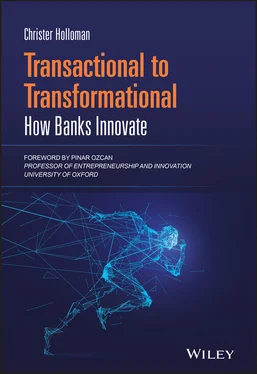207 199
208 200
209 201
210 202
211 203
212 205
213 207
214 208
215 209
216 210
217 211
218 212
219 213
220 214
221 215
222 216
223 217
224 218
225 219
226 220
227 221
228 222
229 223
230 224
231 225
232 226
233 227
234 228
235 229
236 230
237 231
238 232
239 233
240 234
241 235
242 236
243 237
244 238
245 239
246 240
247 241
248 242
249 243
250 244
251 245
252 246
253 247
254 248
255 249
256 250
257 251
Reading this book has been a great way to validate what we are already doing as well as giving a lot of new ideas about what we could be doing next!
Jan Strang
Head of Retail Finance
Nordea Bank
An enlightening fact‐based read that provides direction without forcing a solution to what is arguably the biggest challenge faced by businesses today, digital transformation .
Paul O'Leary
Managing Director, UK
IKANO Bank
The challenges overcome by global banks of different nature and size provide readers with a useful tool to be able to embrace innovation themselves .
Alberto Greppi
Head of Investment Team, Neva Finventures
Intesa Sanpaolo
If you work with banks, or in banking, this is a must read crash course in the best practices of their varying innovation models .
Will Mason
Director of Markets and Innovation
Experian
These case studies demonstrate that whilst there are many paths to success, banks need to focus as much on how they approach innovation as what they hope to deliver in order to make a lasting transformation .
Anthony Craufurd
Venture and Startup Engagement Director
VISA Europe
This book shows that there is no silver bullet when it comes to how to drive innovation within companies, it is difficult to innovate within an established corporate culture, flexibility is key and the ability to pivot quickly if needed .
Werner Decker
EVP/GM, Global Merchant Services International
American Express
The success levers and learnings from each case study are very clearly laid out. What I really love about it is that it is practical, actionable and easy to absorb .
Pinar Alpay
Senior Vice President, Global Payment Solutions & Transformation
FIS
Christer's case studies are a valuable resource for operators attempting to drive change in and around financial institutions .
Philip Bodell
Corporate Development Director
Fiserv
Transactional to Transformational
How Banks Innovate
By Christer Holloman

This edition first published 2021
Copyright © 2021 by Christer Holloman.
Registered office
John Wiley & Sons Ltd, The Atrium, Southern Gate, Chichester, West Sussex, PO19 8SQ, United Kingdom
For details of our global editorial offices, for customer services and for information about how to apply for permission to reuse the copyright material in this book please see our website at www.wiley.com.
All rights reserved. No part of this publication may be reproduced, stored in a retrieval system, or transmitted, in any form or by any means, electronic, mechanical, photocopying, recording or otherwise, except as permitted by the UK Copyright, Designs and Patents Act 1988, without the prior permission of the publisher.
Wiley publishes in a variety of print and electronic formats and by print‐on‐demand. Some material included with standard print versions of this book may not be included in e‐books or in print‐on‐demand. If this book refers to media such as a CD or DVD that is not included in the version you purchased, you may download this material at http://booksupport.wiley.com. For more information about Wiley products, visit www.wiley.com.
Designations used by companies to distinguish their products are often claimed as trademarks. All brand names and product names used in this book are trade names, service marks, trademarks or registered trademarks of their respective owners. The publisher is not associated with any product or vendor mentioned in this book.
Limit of Liability/Disclaimer of Warranty: While the publisher and author have used their best efforts in preparing this book, they make no representations or warranties with respect to the accuracy or completeness of the contents of this book and specifically disclaim any implied warranties of merchantability or fitness for a particular purpose. It is sold on the understanding that the publisher is not engaged in rendering professional services and neither the publisher nor the author shall be liable for damages arising herefrom. If professional advice or other expert assistance is required, the services of a competent professional should be sought.
Library of Congress Cataloging-in-Publication Data is Available:
ISBN 978‐1‐119‐79128‐7 (hardback)
ISBN 978‐1‐119‐79132‐4 (ePub)
ISBN 978‐1‐119‐79129‐4 (ePDF)
Cover Design: Wiley
Cover Image: © Liu zishan/Shutterstocks
Conor
Thank you for your support throughout this process
You are destined for greatness
Over their lifetime, banks have not been known for innovation. They have long held a privileged position of trust in society, as safeguards of our wealth and most private information. As such, customers have traditionally been happy with low rates of innovation, with almost 80% of us actively choosing to remain with the big traditional banks, despite financial incentive and regulatory support to switch. This was because, in the old world, we had accepted that security and innovation were an insurmountable trade‐off and that when given the choice, we would rather that our bank kept our money safe than give us more innovative technologies.
As you know very well if you are reading this book, this is no longer true. Following a perfect storm of events that shook both the industry players as well as the expectations of bank customers, we are now living in an age where banks have to compare themselves to, and collaborate with, small fintech and large tech companies in the race to satisfy their customers' needs.
In the events that led to this dramatic change in the banking industry, the 2008 global financial crisis has been considered a cornerstone. The crush of incumbent firms and the banking system led to the loss of customer trust, and the ripples of this shock continued for people who experienced financial losses in the crisis and the following economic downturn. Even though most big banks remained a safe place in people's eyes for keeping their financial assets, lack of transparency and persistent high fees caused a different kind of trust problem that banks needed to solve.
Another driver of the transformation of banks into innovative organisations has been their realisation of the different needs and habits of ‘millennials’ who are starting to become their customers. The differences in this generation's life goals, spending habits and employment patterns from previous generations are stark enough to make any organisation stop and think about reconfiguring their product portfolio. With lower home ownership rates, high student debt, variable employment and income, low trust in established institutions and, perhaps most importantly, high willingness to share their data for better services, millennials require not only a different set of financial services but also a much more data‐driven, personalised approach to their finances.
Читать дальше












